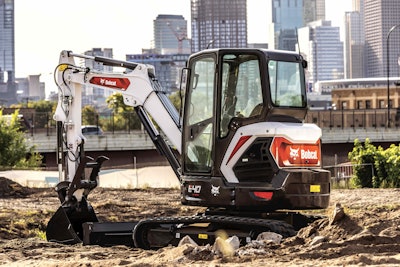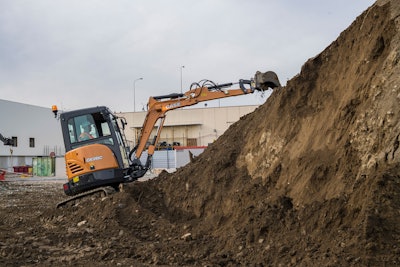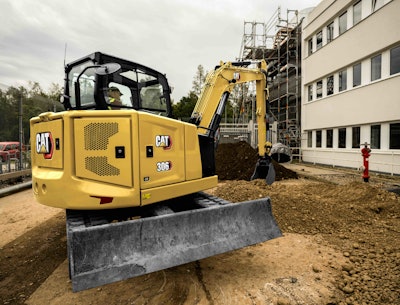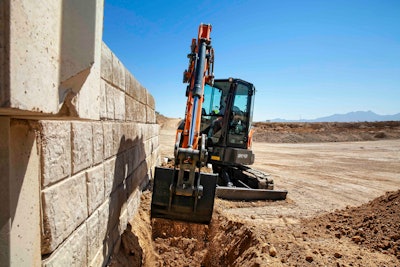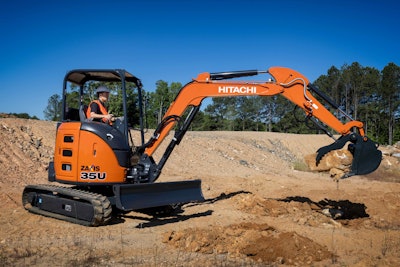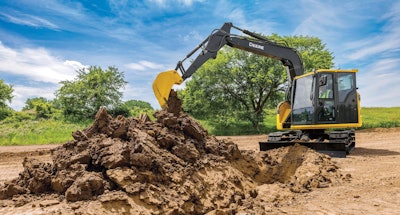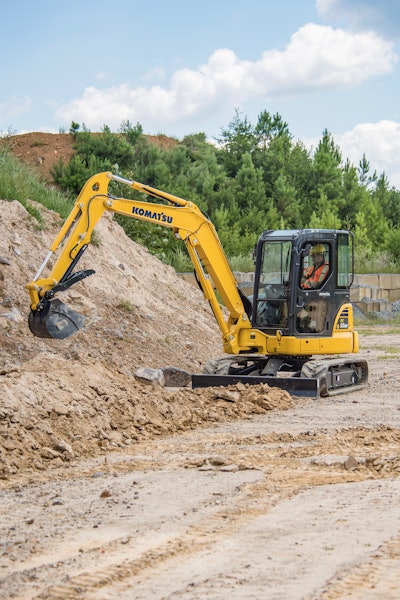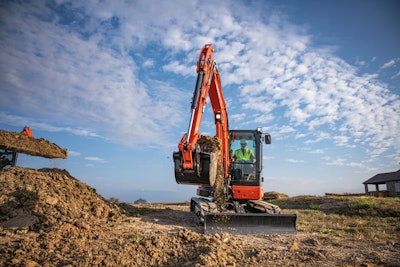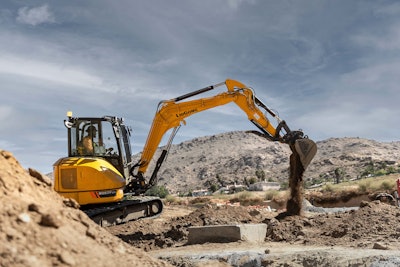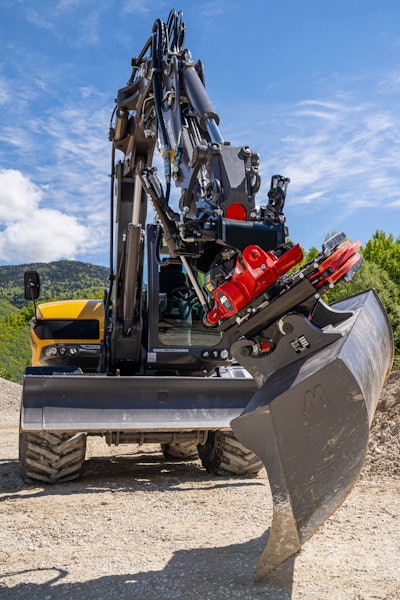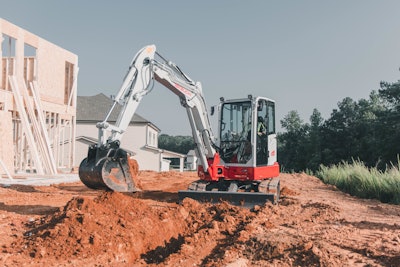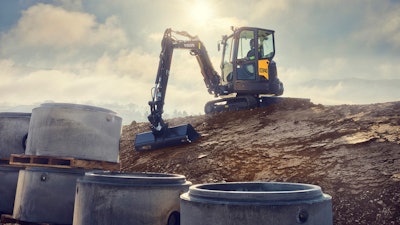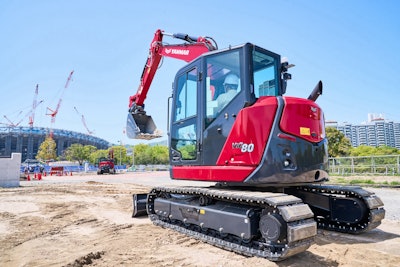Getting the Max from the Mini Excavator: 2024 Buyer’s Guide
This article originally appeared on EquipmentWorld.com – a leading media site serving up the latest news in construction, heavy equipment, pickups and everything else that helps you get the hard work done.
JCB
Source: JCB
JCB’s 35Z-1 is a zero tailswing model with 24.7 horsepower and a 7,840- pound operating weight. The heavy-duty kingpost features durable re-bushable pivots for durability. The suspension seating is fully adjustable. Load-sensing hydraulics, programmable auto-idle and four engine modes improve performance and fuel savings. The sloping H-frame undercarriage is easy to clean.
Compact or mini excavators have exploded in numbers over the years, becoming more popular not only for digging on tight jobsites but as toolcarriers.
As the number of models of compact excavators increases, so do the types of features and technology being added.
Electric compact excavators also continue to make incremental gains. Their significant additional cost is being offset in some market by agencies offering incentives.
Faced with so many choices, how do contractors choose the right compact excavators for their business?
We got guidance from top manufacturers to help you navigate the 2024 compact excavator market.
Bobcat: Choose Your Arms
Source: Bobcat
The Bobcat E40 has an operating weight of 9,180 pounds. Boom swing is 75 degrees left and 55 degrees right. Tailswing is less than 2 inches. The standard long arm provides 10 feet 10 inches of maximum dig depth and maximum reach at ground of 17 feet 11 inches.BobcatEric Dahl, product manager, and Mike Fitzgerald, marketing manager, Bobcat, say the company has focused on advantages that make a real-world difference to the operator. One example is the availability of standard, long and extendable arms.
Extendable arms can add up to 30 inches of reach while keeping original arm and bucket forces. These options help with digging and material handling and reduce the need for machine repositioning. Across the line, Bobcat has increased lift capacity, not only over the blade but also over the side.
Bobcat also offers a depth-check accessory for all R2-Series models with standard or long arms (but not the extendable arm). Depth Check is a wired indicate system with both visual and audible alerts for when the operator is near, at or beyond target depth. Depth Check is compatible with the standard LCD display as well as the optional touchscreen display, which also offers Bluetooth connectivity and the ability to use a rearview camera. An optional laser receiver is available for use on larger jobsites to improve Depth Check accuracy and efficiency.
Case: Stick to the Basics
Source: CASE CE
The Case CX26C is powered by a Kubota D1305 engine rated at 24.8 gross horsepower. Operating weights run from 5,520 pounds (canopy, 3 feet 8 inches short arm) to 6,160 pounds (cab, 4 feet 5 inches long arm with additional counterweight). Boom swing is 75 degrees left and 50 degrees right. Auxiliary flow is 12.2 gallons per minute at 3,133 psi both primary and secondary.Case CEDiego Butzke, product manager, excavators, Case Construction Equipment, says Case makes sure the basics are done right and proceeds from there. For example, if a customer opts for a cab instead of a canopy, that cab comes with heat and air conditioning rather than one or both being separate line items on a spec sheet.
Because thumbs are so popular with compact excavators, Case equips all its excavators with thumb cylinder mount brackets and auxiliary hoses with the stop pad installed. “This makes it very easy for customers to install a thumb if they choose.”
Some Case models include a high-flow option. Even if a customer doesn’t need that high-flow performance at first, things can change.
“We hear this all the time from our customers, especially landscapers who decide to move into foundation work or general construction,” says Butzke. “They wish they would have invested in a machine with more tonnage or an expanded auxiliary hydraulics system.”
The high-flow options provide greater performance in a size class of machine that may be required to meet transportability or other restrictions.
Cat: Advanced as Standard Equipment
Source: Caterpillar
The 57.9-gross-horsepower Cat 306 has an operating weight of 15,766 pounds. Auxiliary flow in the primary circuit is 24 gpm at 3,553 psi, and in the secondary, 9 gpm, also at 3,553 psi. With Cat Stick Steer, operators can switch between traditional lever and pedal travel control to joystick control with the push of a button. Configurations include Extra Tool Carrier (XTC) and straight or angle blade.CaterpillarGreg Worley, 1- to 10-ton mini hydraulic excavator product professional, Cat, says Cat was the first to market with a complete menu of upgraded standard features with its Next Gen models. Examples include cruise control, stick steer and a pressurized cab. While other OEMs may have included some features at some levels, Cat was first to provide an entire set of advanced features as standard equipment, he says.
Worley says technology should be scalable so there’s a level of investment that’s commensurate with the cost of the machine. Cat Grade with 2D is a cost-effective way to enhance operator productivity by up to 35%. “Using round numbers, a $50,000 machine control system makes sense on a $250,000 excavator, but not on a $50,000 mini. For that, a $5,000 to $10,000 system makes better sense. Price must be related to value, and the feature has to pay for itself.”
Even though compact excavators are at the lower end of the cost scale for equipment, Worley says customers should still look at total owning and operating costs. “Think about fuel consumption, filters and other consumables. Think about PM intervals. Think about residual value.”
Develon: Focusing on Reliability
Source: Develon
The DX42-7 from Develon has 47.1 net horsepower, an operating weight of 9,877 pounds, a maximum dig depth of 11 feet 5 inches and a standard bucket of 0.18 cubic yards. This 4-ton class size, conventional tailswing model comes with -7 Series features including thumb mounts and quick-coupler hydraulic piping to the end of the arm. Also standard is the Develon Fleet Management telematics system.DevelonJake Sherman, dealer and product marketing manager, Develon, says that its excavators are designed for long-term reliability. This begins with extensive testing during the development process.
Early adopters of new models of anything – from excavators to cellphones – are often vexed by excessive failure and underperformance of those new designs. It seems at times the first buyers are beta testers. Develon works to ensure new models are fully developed and ready for market before they’re ever released for sale, Sherman says.
Reflecting that confidence, Develon, formerly Doosan Infracore, now offers a 3-year, 5,000-hour full warranty that is transferable.
“We encourage customers to build strong working relationships with their dealers,” says Sherman.
To make sure dealers contribute maximum value to that relationship, Develon is proactive with its dealers to ensure they have the latest information, tools and training to keep Develon equipment up and running.
“We are also bringing standard premium features to the line in 2024,” says Sherman. These include piping to the end of the arm, and on some cab models, rearview camera and air-suspension seating.
Hitachi: Matching Features to Models
Source: Hitachi
The Hitachi ZX35U has a Yanmar 3TNV88F engine rated at 24.7 gross horsepower. Operating weights are 6,680 pounds canopy and 7,055 pounds cab, both with rubber tracks. Auxiliary flow is 16.2 gpm at 2,495 psi. Maximum dig depth is 10 feet. A quiet cab (70.4 dB/A in cab, left side), pilot joystick controls and lights in the cab and on the boom are also standard.HitachiKei Matsumoto, product manager of compact excavators, Hitachi Construction Machinery Americas, says the company offers eight models of compact excavators. Feature sets are carefully matched to provide optimal performance.
The ZX30U-5N through ZX85USB-7 have two work modes: power and economy. They also have auto-idle that drops the engine to idle speed after 4 seconds without operator input at the controls.
The ZX30U-5N and ZX35U-5N now include an auxiliary flow rate change-switch so the operator can choose high or low flow to best meet the needs of attachments.
An optional attachment replacement support system is available for the ZX75US-7 and ZX85USB-7 to simplify tool changes. With the system, flow settings can be adjusted from the monitor, and the operator can name and store up to 12 settings.
An auxiliary function lever (AFL) is available to be coupled with an analog switch, trigger switch and horn for running such attachments as a breaker or those with a swing function.
JCB: Auto-Warm Hydraulics & Other Features
Stephen Grant, product team apprentice, and Javier Martin, heavy line product manager, JCB, pointed out JCB’s auto-warm as one example of value-added features in JCB compact excavators. At the push of a button, the machine uses a heater to warm hydraulic oil, which is circulated through the system bidirectionally; the process takes about 5 minutes.
“This prevents that annoying sluggish response that operators can get with a cold system,” says Martin, “and ensures the seals have warm oil when working pressure is applied.”
Other features to enhance the operator experience include LED lighting, 70/30 (upper/lower) split front glass, a full range of attachments and six zero-tailswing models.
Body panels on JCB compact excavators are 100% steel; “plastic cladding tends to show cracks by 500 hours,” says Grant. Intervals on dig grease points are 500 hours, made possible largely by the use of bronze graphite-impregnated bushings.
JCB continues the Yellow Series packages with the most popular configurations of excavators already built. To these specs, customers can add features and accessories to match their needs.
John Deere: P-Tier Improvements
Source: John Deere
The 75 P-Tier from John Deere has 67.6 net horsepower, operating weight to 19,326 pounds and a maximum dig depth of 15 feet 3 inches. Optional angle blade has float. Auxiliary hydraulics are continuous flow for better heat management, especially with high-demand attachments such as mulchers and hammers.John DeereBrian Riniker, global product manager, small excavators, John Deere, says that because compact excavators are used in so many applications and with so many attachments, optimizing machine settings for specific applications may be needed.
“It’s important to carry the small excavator’s performance traits to all the applications for which those machines are used,” he says.
New Deere excavators have a common menu structure and feel. There is a quick access button and jog dial controller on the Command Arm for quick and easy use of those menus.
Several of Deere’s compact excavators have been brought into the company’s tiering strategy. Improvements to smaller models include the availability of JDLink as a dealer-installed option. The 75 P-Tier and 85 P-Tier have a longer list of improvements including larger monitors with displays for left, right and rearview cameras. The engines are now turbocharged for 18% more overall power and improved performance at altitude. Cabs on the 75 P-Tier and 85 P-Tier have 18% more space and 6.5 inches more leg room.
Riniker says Deere is constantly analyzing field data from JDLink at the factory and will issue alerts to dealers based on trends they see. These alerts may prompt for a software update, superseded parts or any other appropriate solution.
Kato CES: "Tech Pushback"
Source: Kato
The Kato HD308US-7 is powered by a 57-horsepower engine. Operating weight is 19,750 pounds. First line auxiliary circuit provides 30 gpm at 2,700 psi and second line auxiliary is 16 gpm at 3,000 psi. Minimum swing radius is 6 feet 7 inches.KatoBart DeHaven, director of sales, Kato CES, acknowledges, “You can’t please all the people all the time, but we do all we can by adjusting and adapting to meet their needs.” He says as a small, family-owned company, Kato can be more responsive. He cites the example of a customer who contacted Kato on Wednesday needing an excavator on Friday afternoon, “and we made that happen.”
DeHaven says Kato machines, which are made in Japan, have high reliability but are comparatively low tech. “We still use a key ignition.”
He says many customers are pushing back against what they see as tech for tech’s sake, which results in higher costs, complexity, and reliability issues, and the straightforward design of Kato machines appeals to them.
DeHaven says Kato offers four electric models. The 9VXE and 17VXE are tethered models, the first single- or three-phase and the latter three-phase only. Both have battery equivalents, the 9XVB and 17XVB. The tethered models are giving up market share to the battery models.
Kato will introduce the new HD308 at the ARA show this month. It will have features unlike others in the Kato lineup, most notably a fixed boom that DeHaven says is better for high-demand attachments, such as hammers. It also provides greater breakout force.
Komatsu: The Max for Mini Machines
Source: Komatsu
Komatsu’s PC55MR-5 has an operating weight of up to 11,618 pounds and bucket capacities of 0.07 to 0.24 cubic yards. The engine is a naturally aspirated Komatsu 4D88E-7 rated at 38 net horsepower. Hydraulics are the Komatsu closed-center load-sensing system (CLSS) for fast response and smooth operation.KomatsuKurt Moncini, senior product manager, Komatsu, says its compact excavators are designed and built with the same care as its biggest models.
As an example, Komatsu uses castings where other OEMs may use fabrications. Komatsu also designs and builds its own components. “Even when we do source from established component suppliers, Komatsu often refines the specs to ensure peak performance with our machines.”
Even the manuals are standardized; the information provided, and the presentation of that information is as clear and comprehensive for the smallest Komatsu excavator as for the largest Komatsu dozer, he says.
The problem, says Moncini, is that compact equipment can be seen as a lower-value investment; so the advantages of Komatsu’s attention to longevity, for example, can be lost on some customers. “But for anyone running their machines even slightly more than the average hours or using them in more demanding applications, the benefits of a robust design become quickly apparent in reduced downtime and lower O&O costs.”
Moncini offers two quick tips for buyers. Customers running high-demand attachments may need to move up one model from what their lift specs may indicate to get sufficient hydraulic performance.
Also, modern telematics reveal much more than fault codes. “If there’s a big difference in fuel level from key-off to key-on, that can indicate fuel theft,” he says.
Kubota: Focus on Your Needs
Source: Kubota
New features on the Kubota KX057-5 include a standard 7-inch color display with jog dial, keyless start, LED working lights and factory prep for a dealer-installed rearview camera. The Kubota V2607-CR-E5 engine is rated at 47.6 gross horsepower. Operating weights range from 5,535 pounds (canopy, rubber tracks, straight blade) to 6,050 pounds (cab, steel tracks, angle blade).KubotaBill Holton, Kubota product manager, says customers can help ensure they get the right product by coming to their dealer with good answers to common questions: What brings you in today? What would a typical day on the job look like?
Work with the dealer to get the right features, options and attachments and be willing to challenge your assumptions. For example, a ROPS station may be a better choice in some applications than a cab.
LiuGong: Brand-Name Components
Source: LiuGong
The largest LiuGong compact excavator, the 9057FZTS, has a Yanmar engine rated at 48 gross horsepower and an operating weight of up to 13,999 pounds. Maximum flow is 20 gpm for auxiliary 1, and 10 gpm for auxiliary 2, both at 2,900 psi. Maximum dig depth is 11 feet 11 inches. Standard bucket capacity is 0.21 cubic yards.LiuGongJim Joy, excavator product manager, LiuGong, says, “The strategy LiuGong has taken for not only the compact excavators, but its entire portfolio, is to use well-accepted brand components and integrate them into a high-quality chassis.
“For example, LiuGong utilizes the popular Yanmar engine in platforms under 100 horsepower, along with Hengli hydraulics, which pair well together.” He says this allows LiuGong to deliver quality at a lower price.
Joy encourages customers to “put aside your stereotypes, especially when it comes to overseas suppliers.” Instead, he says, focus on quality, performance, return on investment and dealer relations. He notes that the parts distribution center for LiuGong in the U.S. is centrally located in Houston, Texas, for prompt delivery of parts when needed.
LiuGong will continue rollout of two new models early in 2024, the 9051FZTS and 9057FZTS. Both were on display at ConExpo 2023. Both are zero tailswing and rated at 48 gross horsepower, and both come with standard bucket and thumb, angle blade and electronically adjustable auxiliary circuits.
Mecalac: Integrated Tiltrotator
Source: Mecalac
The Mecalac Tiltrotator further enhances the versatility of Mecalac compact excavators. The tiltrotator is between two Mecalac Connect couplers. Tilt is 40 degrees to either side. There is a “home” function that returns to the operator preset position, bucket shake and low pin-to-pin height, which preserves bucket breakout force. Mecalac offers three versions of the tiltrotator to fit a range of its excavators.MecalacPeter Bigwood, general manager, Mecalac North America, says the company now has three tiltrotators, the MR40, MR50 and MR60.
“The important thing is that the tiltrotator is truly integrated with the Mecalac excavator,” says Bigwood. Although the operator must manually connect and disconnect the hydraulic hoses with the tiltrotator, it attaches via the standard Mecalac Connect system and has another Connect coupler for buckets and attachments. It preserves the benefits of the Mecalac Connect system while adding the versatility of a tiltrotator.
The three-section boom and stick design of Mecalac excavators already offers performance advantages for grading, angle and curves, and the tiltrotator adds 360 degrees of rotation and 40 degrees of angle left and right for even greater utility.
The tiltrotator can be ordered with a gripper so the tiltrotator can be used with no attachment in place. Mecalac excavators can be ordered tiltrotator-ready with the circuitry, plumbing and hardware for later dealer installation.
While skid steer buckets can be used with Mecalac compact excavators, they are not recommended for use with the tiltrotator due to the higher torsional loads created by those buckets.
Takeuchi: Reduced Tailswing
Source: Takeuchi
The Takeuchi TB350R is powered by a Kubota engine rated at 41.7 horsepower. Operating weights are 10,980 pounds with canopy and 11,235 pounds with cab. Auxiliary flow is 24.6 gpm at 2,990 psi. The cab includes heat, air conditioning, defrost, AM/FM radio with Bluetooth and a skylight with sunshade. Two years of Takeuchi Fleet Management telematics are included.TakeuchiDavid Caldwell, national product manager, Takeuchi-US, says the company has recently introduced new reduced-tailswing models in the 3.5- and 5-metric-ton categories.
These machines also have new cab and canopy features, including new color monitors. Cab models have a touchscreen with jog dial, “making it easier than ever to navigate various machine functions such as adjusting flow rates, controlling HVAC and radio functions, attachment setup presets and user profiles,” he says.
The new TB350R joins five other models that feature three auxiliary circuits as well as high-flow capabilities. “As a result, they’re exceptional attachment platforms capable of running a wide range of hydraulically driven attachments,” Caldwell says.
Volvo: Built for Pros
Source: Volvo Construction Equipment
The Volvo ECR40 has a Volvo D1.7A engine rated at 24.8 horsepower. Operating weights are 8,543 pounds canopy and 8,785 pounds cab, which is the standard configuration. Attachment presets can be programmed in, and operators can be restricted to just the presets or have the option of making final hydraulic adjustments. Coupler options include the standard mechanical, Volvo universal hydraulic quick coupler and Steelwrist hydraulic quick coupler.Volvo Construction EquipmentDarren Ashton, compact product manager for North America, Volvo Construction Equipment, cites a fact that seems outside the current narrative.
While we all know the shortage of skilled operators is a persistent problem, Ashton says that with compact excavators the greater factor is the growth of highly skilled operators. “While there’s still an overall shortage, the average operator of a compact excavator today is much more proficient than the average operator of just a few years ago.” This is because as compact excavators have dramatically improved with more power, more attachments and more features. Operators are spending more time in the cabs doing more diverse operations and more of each of those operations.
“It used to be you put the least-skilled operator in the compact machine because they were simple to operate,” he says. “Now you put a pro in there to extract the greatest value from the machine.”
As a consequence, Volvo compact excavators have features pros expect. The cabs are large with large doors. There are full-size foot pedals. Controls float with the seat so their position relative to the seat remains consistent over rough terrain.
The newest models have a jog wheel, quick coupler and 5-inch display. Feedback through that display helps operators with such information as visual step-by-step instructions for changing attachments.
Volvo offers single and bidirectional, adjustable hydraulic flow. The amenities extend to 50-hour grease intervals, placement of the fuse panel inside the door for easy access and a one-piece hood for easy access to other service points, including the alternator and starter.
Yanmar: The Next Generation
Source: Yanmar
The 67-horsepower ViO80-7 is the largest of Yanmar’s zero tailswing models. Operating weight is 18,409 pounds with rubber tracks and 18,453 pounds with steel tracks, both with cab. The 2PLS (two-pump, load-sensing) hydraulics yield up to 13% better fuel efficiency. SmartAssist telematics provide data analytics and help optimize PM schedules.YanmarZac Evans, product manager, excavators and carriers, Yanmar, says the company launched its -7 Series in the third quarter of 2023 with shipments commencing in the fourth quarter.
The -7 Series machines feature Yanmar’s new cab with improved visibility, both direct and by means of standard rear- and side-view cameras and 7-inch monitor. A new quick coupler with a double lock on the front and rear of the pin allows attachment changes from the cab. Access is improved to daily check points as well as key maintenance and service locations and the main control valve.
Yanmar also changed the hydraulic architecture of the -7 Series machines. It went from a three-pump flow-sharing system to a two-pump load-sensing system for better performance and efficiency. This yields up to 20% more flow while also improving fuel efficiency by up to 13% at full engine speed.
Electric Excavators
The logistics of charging, battery replacement and recycling, and specialized service tools and training are slowly being improved.
Electric compact excavators are still mostly destined for applications where noise and emissions are dictating are a concern, but their encroachment on traditional sites is proceeding modestly.
Market Conditions
Meanwhile, the equipment industry is emerging from the challenges of the Covid pandemic with supply chain issues, production problems and the piecemeal availability of finished machines mostly behind us.
And unlike several consumer segments where post-Covid overproduction outpaced demand, leading to deep discounts and even some business failures, the supply and demand of construction equipment, including compact excavators, has remained balanced.


